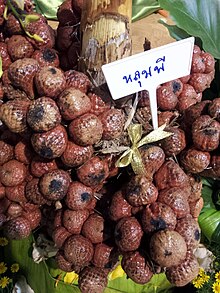Eleiodoxa conferta
| Eleiodoxa conferta | ||||||||||||
|---|---|---|---|---|---|---|---|---|---|---|---|---|
| Systematics | ||||||||||||
|
||||||||||||
| Scientific name of the genus | ||||||||||||
| Eleiodoxa | ||||||||||||
| ( Becc. ) Burret | ||||||||||||
| Scientific name of the species | ||||||||||||
| Eleiodoxa conferta | ||||||||||||
| ( Handle. ) Burret |
Eleiodoxa conferta is a species of palm native to Southeast Asia. It is the only representative of the genus Eleiodoxa .
features
Eleiodoxa conferta is a trunkless palm that forms dense groups. It is reinforced and blooms only once in a lifetime ( hapaxanth ). She is diocesan . The trunk is underground and has short internodes . Side rungs arise axillary.
The number of chromosomes is not known.
leaves
The leaves are pinnate and remain on the plant after they die. The leaf sheath is busy with the exception of the lowermost end with whorls of spines and with scales. The petiole is also provided with spines, as is the rachis . The leaflets are simply folded, linear-lanceolate and arranged regularly. The leaf margins are provided with short spines.
Inflorescences
The inflorescences are united to form a compound, terminal inflorescence. This is located at ground level between the leaf bases. The axes of the first order carry upright, cylindrical, cat-like rachillae . On these the flowers stand in pairs in the axils of the bracts. The flower pairs consist in the male inflorescences of two fertile male flowers , in the female from a fertile female and a sterile male.
blossoms
The male flowers are tinted pink at flowering time. The chalice is cup-shaped with three lobes. The crown is tubular at the base and divided into three triangular lobes about four-fifths. The six stamens are at the mouth of the corolla tube. The stamens are fleshy and long, sharply narrowed at the tip and bent inward. The anthers are elongated and intrors. A stamp rudiment is not available.
The sterile male flowers are similar to the fertile ones, but the stamens are fleshy and the anthers are empty.
The female flowers are similar to the male, but are significantly larger. The crown is tubular in the lower third. The six staminodes are at the mouth of the corolla tube, the stamens lie against the corolla, the empty anthers are arrow-shaped. Dis Gynoeceum consists of three intergrown carpels, has three ovules , is spherical and covered with scales.
Fruits and seeds
The sour fruits are mostly solitary and have an apical style remnant. The exocarp is covered with vertical rows of scales pointing backwards. The mesocarp is somewhat spongy, an endocarp is not differentiated. The seed is plump with a thick, sour tasting sarcotesta . The endosperm is homogeneous.
Distribution and locations
The species occurs in Southeast Asia and western Malesia : southern Thailand , Malay Peninsula, Sumatra and Borneo . It is a characteristic representative in the undergrowth of lowland freshwater swamps. It occurs particularly frequently in peat swamp forests with a certain movement of water.
Systematics
The genus Eleiodoxa (Becc.) Burret is placed within the family Arecaceae in the subfamily Calamoideae , tribe Calameae . Here it forms the Subtribus Salaccinae together with its sister genus Salacca .
In the World Checklist of Selected Plant Families of the Royal Botanic Gardens, Kew, only the species Eleiodoxa conferta (Griff.) Burret is recognized.
The name Eleiodoxa is derived from the ancient Greek words for swamp and fame and refers to the location of the palm trees.
use
The leaves are sometimes used for roofing. The very acidic sarcotesta is sometimes used as a tamarind substitute for cooking. It can also be used to make a dessert with sugar.
supporting documents
- John Dransfield, Natalie W. Uhl, Conny B. Asmussen, William J. Baker, Madeline M. Harley, Carl E. Lewis: Genera Palmarum. The Evolution and Classification of Palms . Second edition, Royal Botanic Gardens, Kew 2008, ISBN 978-1-84246-182-2 , pp. 170-172.
Individual evidence
- ↑ Rafaël Govaerts (ed.): Eleiodoxa. In: World Checklist of Selected Plant Families (WCSP) - The Board of Trustees of the Royal Botanic Gardens, Kew . Retrieved March 5, 2010.
Web links
- Eleiodoxa on the homepage of the Fairchild Tropical Botanic Garden
